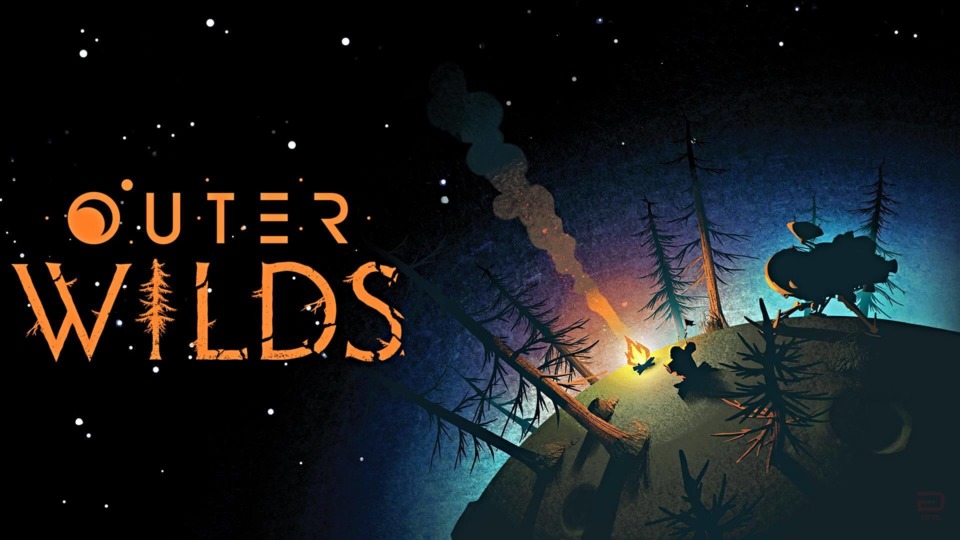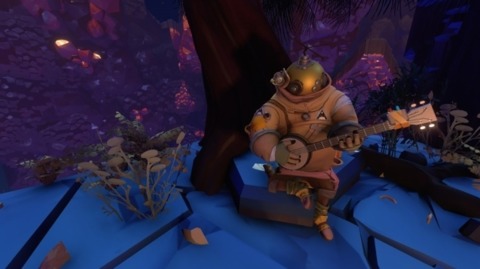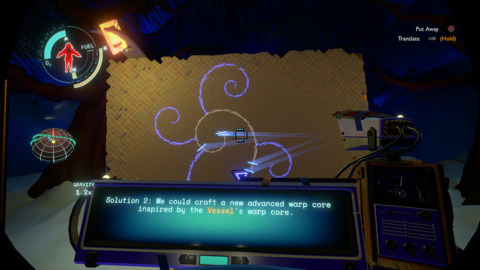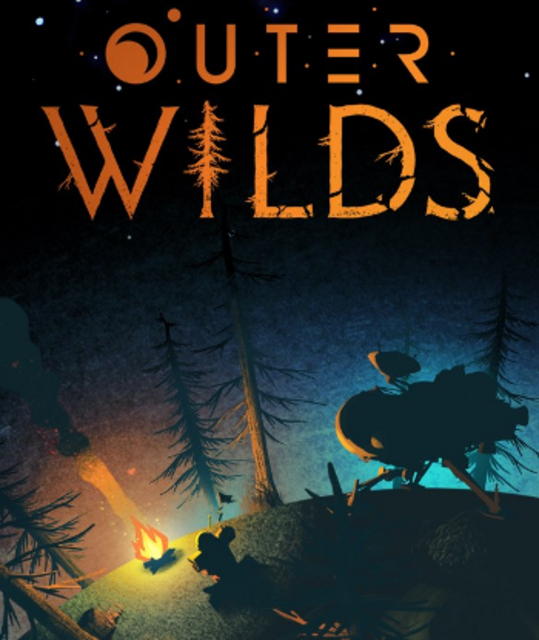Hurry up and wait

“The bad news is time flies. The good news is you’re the pilot.”
OUTER WILDS 2019, XBOX ONE

Many games present us with the conceit of freeform exploration and discovery, but few manage to make good on this promise. Typically exploration is confined by invisible walls or bright red turn-back signals that steer us away from the less interesting parts of the canvas. The stories found within tend to start and stop with the NPC’s we encounter along the way and their menial errands serve as tour guide. When the walls are lifted it is often to the tune of procedural generation that presents us with infinitely expanding horizons that lack detail and meaning. So it is shocking that where giants have failed, a small indie experience resoundingly triumphs. Through a tumultuous journey that originates back to 2012 as a masters thesis project, a text adventure, the first ever campaign to launch on newly minted crowdfunding site Fig to finally being bought out by film production house and sometimes game publisher Annapurna Interactive - Outer Wilds delivers on the promise of freeform exploration with honors.
The story begins as many of ours do, by waking up and having a hot marshmallow for breakfast. As a brand new space cadet of an alien race just coming to grips with space exploration, it is time for you to take your first leap among the stars. There is no incoming attack, no important mission for you to embark on. In fact the atmosphere at Timber Hearth, your home planet of green trees and four eyed “Hearthians” having an unhealthy addiction to sugar on a stick, is incredibly laid back. Fellow aliens sit around camp fires or go about their day, the entire planet feeling like one big summer camp. As you enter your spacecraft that seems to be cobbled together from random parts found in a junkyard and wooden scaffolding, wires a-mess everywhere, your primary objective is to just “get out there kid” and have a look around the solar system. No pressure. Lifting off, the world rapidly transforms into a miniature playset. The moment you’re in the air Timber Hearth begins to curve at the horizon and seconds later it is a neat round ball of trees and hills beneath your landing struts as the vast solar system spreads before you with a radiant sun at it’s center. The world is your oyster and you can go anywhere and do anything, until it suddenly ends.
It is impossible to talk about Outer Wilds without mentioning it’s biggest surprise and primary gameplay mechanic. Every 22 minutes the sun goes suprnova and the day resets. In a Groundhog Day inspired time loop, you take on the role of four eyed Bill Murray trying to unfold the mystery of what is happening and you do so one loop at a time. And much like Bill Murray, at the start of each loop you are armed with the knowledge of all that came before it. With an infinite amount of time on your hands, it's now only a question of how to use it.
At its core Outer Wilds is an adventure game with a hint of first person platforming. There is no combat and the only hostile forces to contend with are the hazardous environments you often find yourself visiting. Armed with a few basic tools like a signal-finder or a remote-control-camera, you are let loose on the handful of planets orbiting the sun and left unimpeded throughout each time loop. You can quite literally go anywhere and do anything within your allotted time span. To give some form and structure to your adventure is a really well implemented onboard computer journal that compiles all the data you learn throughout each loop into a clever web of interest points. Each time you uncover something new the web gets updated back on the ship, drawing lines between linked locations and letting you know what you’ve learned there and most importantly if there is more to be learned. Using this clever navigational system you can quite literally start to connect the dots to what is happening and most importantly what has already happened.

The concept of what has happened is an important one. In Outer Wilds almost the entirety of your travels will be spent uncovering the trials and tribulations of a civilization long gone. One of your three primary tools is a translation device that is capable of deciphering alien writing left behind by the race that inhabited the solar system long before the Hearthians put marshmallow to fire. This highly advanced civilization, capable of technological feats far surpassing that of the Timber Hearth folk, serve as your teachers in the solar system. It is through their ruin that you come to understand the world as it is now. Plenty of characters have recurring roles in the many conversations left scrawled on weathered ruin walls, but while I recognized the names I did have a hard time remembering who “Yarrow” was and where was the last time I encountered them. Were they the ones working on the so and so? Or was that Pye.. Simple color coding would have gone a long way in keeping an instantly recognizable through-line in all the dialog that you comb through, but ultimately the names only serve to add a bit of character to what is essentially second hand story exposition. This environmental storytelling while nothing new, in this unique context works surprisingly well. I have never been one to care about world building through incidental lore like hacked e-mails in Deux Ex or books in Dishonored, despite genuinely enjoying those worlds. Yet in Outer Wilds I eagerly awaited the next wall of text I encountered in hopes of uncovering another small piece of the larger puzzle. The system works so well because the game doesn’t present any exposition on it’s own - all the story has to be uncovered by the player which makes the act that much more motivating and rewarding.
Reading is only half the battle. Much of the key narrative tidbits will be locked away in areas that require a bit of creative puzzle solving to access and some good ol' fashioned exploration. Each of the worlds you can visit in Outer Wilds is extremely unique and requires you to learn it’s particular rhythms and mechanics. The amount of detail and sheer ingenuity to that goes into a single planet is astounding. The soft, cartoony art style devoid of fine detail works wonderfully with a lot of the monumental architecture you encounter. Each of the planets has it's own particular biome: one is a sprawling ocean while another is an arid desert. There is a world where gravity is constantly shifting around a central axis that creates scenes straight out of Inception, where an entire city is hanging from a ceiling above you. Some of the vistas you encounter are truly breathtaking without the need for raytracing or ultra-detailed textures - it's just really great art design. In terms of puzzles these planets draw comparisons to Myst where you were often tasked with completing logic problems by finding the solution in the environment surrounding you. Sometimes it’s a matter of finding the right path, sometimes it’s a trick that can only be learned through some notes left behind on a nearby wall. Sometimes you have to cleverly employ one of your tools like the remote control camera that can highlight hazards or the signal finder that can home in on distress beacons and lead you. The beauty of these puzzles is that they are not triggered by story progression. You don’t have to learn something for the solution to start working. It is entirely possible to brute force certain obstacles or if you are exceedingly perceptive simply deduct the right set of moves. Sometimes though it’s simply a matter of being in the right place at the right time, literally, and that can be an issue.

The world of Outer Wilds is constantly in motion, constantly changing to the beat of an internal doomsday clock. Like the above mentioned Groundhog Day where Bill Murray wakes each morning on the same day and through repetition learns with excruciating detail exactly where to be at what time to best game the system, so do you as the player need to start anticipating what comes next through repeat visits. While being as vague as possible, several of the planets undergo dramatic transformations throughout their cycle around the sun that can both impede and advance your progress - the key is learning where to be and when. This is the part of the game that starts out incredibly novel but by the end became increasingly tedious. Outer Wilds doesn’t present the player with any way to actually advance time forward, and plenty of key solutions are locked behind this when-and-where conundrum. It is very easy to miss your window of opportunity and have nothing left to do but re-do the entire loop all over again. This is furthermore complicated by the fact that you cannot reset the loop itself by any other means than death, which is sometimes easier said than done. If you were to say, get stranded in outer space without the possibility to return to your ship, the only choices are to wait it out or purposefully suffocate your Hearthian explorer. You could exit back out to the main menu but the load times make this an even longer proposition. Worse still some of the later game puzzles require quite lengthy periods of time to pass before you can even begin to attempt the solution. When you’ve uncovered everything there is to see and have nothing to do in the meantime, all that is left is to sit there and wait. Factor in that some of the clues are vague enough where it’s easy to assume an incorrect solution and you can dedicate a lot of downtime to pointless pursuits since there is no way to quickly try something several times in a row. All the game needed was a watch or a device that would let you artificially fast forward to the point you need to be in. Possibly a future patch might bring this solution around, or possibly the creators thought it would cheapen their intricately constructed Rube Goldberg pocket universe. As is some puzzles can become increasingly frustrating as you're told to hurry up and wait until the game is ready for you to move on.

The biggest issue Outer Wilds has to contend with is nailing the final act. The initial hours of exploration are wonderful. The elation of completely free-form exploration is truly unparalleled even among the biggest titles out there to date. The mid portion where you gain a handle on the world and start to actively seek specific answers to previously uncovered questions is empowering in your understanding of how the world works. It’s the home stretch that becomes increasingly muddled, with hints becoming increasingly scarce and story points increasingly talking in circles rather than presenting concrete resolutions. While there is something to be said for things being left vague for the sake of interpretation, Outer Wilds in it’s early hours crafts such a precise and logical world that I was expecting an equally concise finale. This isn’t even mentioning the home stretch sprint which is part stealth section, part maze, and 100% counter intuitive to how laid back and consequence free the exploration had felt up to that point. To be clear some elements of the story are quite clearly explained, even if the science of it all will make you pause and possibly draw some diagrams on a napkin. It’s the bigger picture that remains quite vague by the time the credits drop which had me scouring forums on the internet for any sort of long form analysis. Then again considering that creator Alex Beachum cites 2001: Space Odyssey as one of his primary inspirations maybe the rather ethereal nature of it all shouldn’t be that surprising.
Despite a rough final act Outer Wilds is a crowning achievement of ingenuity and a shining beacon of hope for shorter bespoke experiences in a market where indie titles are increasingly procedurally generated affairs. While my absolute awe and love for this game started to wane in the end as several elements were beginning to test my patience, it is still an experience like no other in recent years. Highly recommended to any would be space cadets that love to uncover worlds through exploration rather than glowing quest markers.
